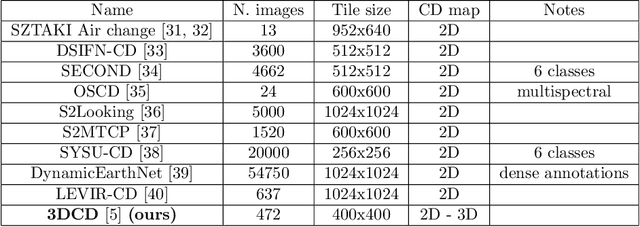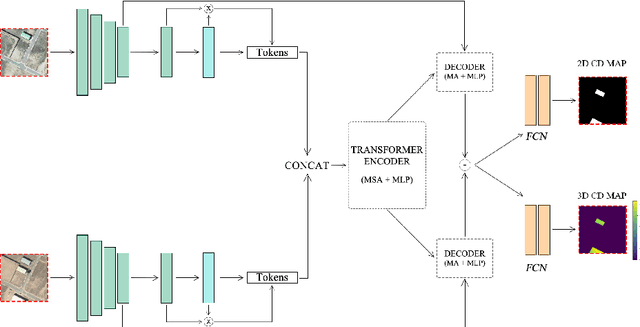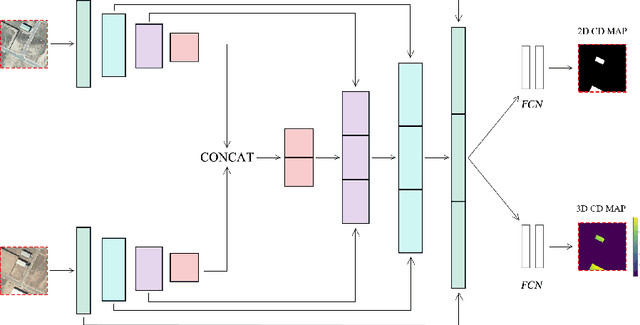Valerio Marsocci
CEDRIC - VERTIGO, CNAM
TerraMind: Large-Scale Generative Multimodality for Earth Observation
Apr 15, 2025



Abstract:We present TerraMind, the first any-to-any generative, multimodal foundation model for Earth observation (EO). Unlike other multimodal models, TerraMind is pretrained on dual-scale representations combining both token-level and pixel-level data across modalities. On a token level, TerraMind encodes high-level contextual information to learn cross-modal relationships, while on a pixel level, TerraMind leverages fine-grained representations to capture critical spatial nuances. We pretrained TerraMind on nine geospatial modalities of a global, large-scale dataset. In this paper, we demonstrate that (i) TerraMind's dual-scale early fusion approach unlocks a range of zero-shot and few-shot applications for Earth observation, (ii) TerraMind introduces "Thinking-in-Modalities" (TiM) -- the capability of generating additional artificial data during finetuning and inference to improve the model output -- and (iii) TerraMind achieves beyond state-of-the-art performance in community-standard benchmarks for EO like PANGAEA. The pretraining dataset, the model weights, and our code is open-sourced under a permissive license.
TerraMesh: A Planetary Mosaic of Multimodal Earth Observation Data
Apr 15, 2025Abstract:Large-scale foundation models in Earth Observation can learn versatile, label-efficient representations by leveraging massive amounts of unlabeled data. However, existing public datasets are often limited in scale, geographic coverage, or sensor variety. We introduce TerraMesh, a new globally diverse, multimodal dataset combining optical, synthetic aperture radar, elevation, and land-cover modalities in an Analysis-Ready Data format. TerraMesh includes over 9 million samples with eight spatiotemporal aligned modalities, enabling large-scale pre-training and fostering robust cross-modal correlation learning. We provide detailed data processing steps, comprehensive statistics, and empirical evidence demonstrating improved model performance when pre-trained on TerraMesh. The dataset will be made publicly available with a permissive license.
COP-GEN-Beta: Unified Generative Modelling of COPernicus Imagery Thumbnails
Apr 14, 2025Abstract:In remote sensing, multi-modal data from various sensors capturing the same scene offers rich opportunities, but learning a unified representation across these modalities remains a significant challenge. Traditional methods have often been limited to single or dual-modality approaches. In this paper, we introduce COP-GEN-Beta, a generative diffusion model trained on optical, radar, and elevation data from the Major TOM dataset. What sets COP-GEN-Beta apart is its ability to map any subset of modalities to any other, enabling zero-shot modality translation after training. This is achieved through a sequence-based diffusion transformer, where each modality is controlled by its own timestep embedding. We extensively evaluate COP-GEN-Beta on thumbnail images from the Major TOM dataset, demonstrating its effectiveness in generating high-quality samples. Qualitative and quantitative evaluations validate the model's performance, highlighting its potential as a powerful pre-trained model for future remote sensing tasks.
Parameter-Efficient Adaptation of Geospatial Foundation Models through Embedding Deflection
Mar 12, 2025



Abstract:As large-scale heterogeneous data sets become increasingly available, adapting foundation models at low cost has become a key issue. Seminal works in natural language processing, e.g. Low-Rank Adaptation (LoRA), leverage the low "intrinsic rank" of parameter updates during adaptation. In this paper, we argue that incorporating stronger inductive biases in both data and models can enhance the adaptation of Geospatial Foundation Models (GFMs), pretrained on RGB satellite images, to other types of optical satellite data. Specifically, the pretrained parameters of GFMs serve as a strong prior for the spatial structure of multispectral images. For this reason, we introduce DEFLECT (Deflecting Embeddings for Finetuning Latent representations for Earth and Climate Tasks), a novel strategy for adapting GFMs to multispectral satellite imagery with very few additional parameters. DEFLECT improves the representation capabilities of the extracted features, particularly enhancing spectral information, which is essential for geoscience and environmental-related tasks. We demonstrate the effectiveness of our method across three different GFMs and five diverse datasets, ranging from forest monitoring to marine environment segmentation. Compared to competing methods, DEFLECT achieves on-par or higher accuracy with 5-10$\times$ fewer parameters for classification and segmentation tasks. The code will be made publicly available.
Can Generative Geospatial Diffusion Models Excel as Discriminative Geospatial Foundation Models?
Mar 10, 2025Abstract:Self-supervised learning (SSL) has revolutionized representation learning in Remote Sensing (RS), advancing Geospatial Foundation Models (GFMs) to leverage vast unlabeled satellite imagery for diverse downstream tasks. Currently, GFMs primarily focus on discriminative objectives, such as contrastive learning or masked image modeling, owing to their proven success in learning transferable representations. However, generative diffusion models--which demonstrate the potential to capture multi-grained semantics essential for RS tasks during image generation--remain underexplored for discriminative applications. This prompts the question: can generative diffusion models also excel and serve as GFMs with sufficient discriminative power? In this work, we answer this question with SatDiFuser, a framework that transforms a diffusion-based generative geospatial foundation model into a powerful pretraining tool for discriminative RS. By systematically analyzing multi-stage, noise-dependent diffusion features, we develop three fusion strategies to effectively leverage these diverse representations. Extensive experiments on remote sensing benchmarks show that SatDiFuser outperforms state-of-the-art GFMs, achieving gains of up to +5.7% mIoU in semantic segmentation and +7.9% F1-score in classification, demonstrating the capacity of diffusion-based generative foundation models to rival or exceed discriminative GFMs. Code will be released.
PANGAEA: A Global and Inclusive Benchmark for Geospatial Foundation Models
Dec 05, 2024Abstract:Geospatial Foundation Models (GFMs) have emerged as powerful tools for extracting representations from Earth observation data, but their evaluation remains inconsistent and narrow. Existing works often evaluate on suboptimal downstream datasets and tasks, that are often too easy or too narrow, limiting the usefulness of the evaluations to assess the real-world applicability of GFMs. Additionally, there is a distinct lack of diversity in current evaluation protocols, which fail to account for the multiplicity of image resolutions, sensor types, and temporalities, which further complicates the assessment of GFM performance. In particular, most existing benchmarks are geographically biased towards North America and Europe, questioning the global applicability of GFMs. To overcome these challenges, we introduce PANGAEA, a standardized evaluation protocol that covers a diverse set of datasets, tasks, resolutions, sensor modalities, and temporalities. It establishes a robust and widely applicable benchmark for GFMs. We evaluate the most popular GFMs openly available on this benchmark and analyze their performance across several domains. In particular, we compare these models to supervised baselines (e.g. UNet and vanilla ViT), and assess their effectiveness when faced with limited labeled data. Our findings highlight the limitations of GFMs, under different scenarios, showing that they do not consistently outperform supervised models. PANGAEA is designed to be highly extensible, allowing for the seamless inclusion of new datasets, models, and tasks in future research. By releasing the evaluation code and benchmark, we aim to enable other researchers to replicate our experiments and build upon our work, fostering a more principled evaluation protocol for large pre-trained geospatial models. The code is available at https://github.com/VMarsocci/pangaea-bench.
Cross-sensor self-supervised training and alignment for remote sensing
May 16, 2024



Abstract:Large-scale "foundation models" have gained traction as a way to leverage the vast amounts of unlabeled remote sensing data collected every day. However, due to the multiplicity of Earth Observation satellites, these models should learn "sensor agnostic" representations, that generalize across sensor characteristics with minimal fine-tuning. This is complicated by data availability, as low-resolution imagery, such as Sentinel-2 and Landsat-8 data, are available in large amounts, while very high-resolution aerial or satellite data is less common. To tackle these challenges, we introduce cross-sensor self-supervised training and alignment for remote sensing (X-STARS). We design a self-supervised training loss, the Multi-Sensor Alignment Dense loss (MSAD), to align representations across sensors, even with vastly different resolutions. Our X-STARS can be applied to train models from scratch, or to adapt large models pretrained on e.g low-resolution EO data to new high-resolution sensors, in a continual pretraining framework. We collect and release MSC-France, a new multi-sensor dataset, on which we train our X-STARS models, then evaluated on seven downstream classification and segmentation tasks. We demonstrate that X-STARS outperforms the state-of-the-art by a significant margin with less data across various conditions of data availability and resolutions.
Conditional computation in neural networks: principles and research trends
Mar 12, 2024



Abstract:This article summarizes principles and ideas from the emerging area of applying \textit{conditional computation} methods to the design of neural networks. In particular, we focus on neural networks that can dynamically activate or de-activate parts of their computational graph conditionally on their input. Examples include the dynamic selection of, e.g., input tokens, layers (or sets of layers), and sub-modules inside each layer (e.g., channels in a convolutional filter). We first provide a general formalism to describe these techniques in an uniform way. Then, we introduce three notable implementations of these principles: mixture-of-experts (MoEs) networks, token selection mechanisms, and early-exit neural networks. The paper aims to provide a tutorial-like introduction to this growing field. To this end, we analyze the benefits of these modular designs in terms of efficiency, explainability, and transfer learning, with a focus on emerging applicative areas ranging from automated scientific discovery to semantic communication.
GeoMultiTaskNet: remote sensing unsupervised domain adaptation using geographical coordinates
Apr 16, 2023Abstract:Land cover maps are a pivotal element in a wide range of Earth Observation (EO) applications. However, annotating large datasets to develop supervised systems for remote sensing (RS) semantic segmentation is costly and time-consuming. Unsupervised Domain Adaption (UDA) could tackle these issues by adapting a model trained on a source domain, where labels are available, to a target domain, without annotations. UDA, while gaining importance in computer vision, is still under-investigated in RS. Thus, we propose a new lightweight model, GeoMultiTaskNet, based on two contributions: a GeoMultiTask module (GeoMT), which utilizes geographical coordinates to align the source and target domains, and a Dynamic Class Sampling (DCS) strategy, to adapt the semantic segmentation loss to the frequency of classes. This approach is the first to use geographical metadata for UDA in semantic segmentation. It reaches state-of-the-art performances (47,22% mIoU), reducing at the same time the number of parameters (33M), on a subset of the FLAIR dataset, a recently proposed dataset properly shaped for RS UDA, used for the first time ever for research scopes here.
Inferring 3D change detection from bitemporal optical images
May 31, 2022



Abstract:Change detection is one of the most active research areas in Remote Sensing (RS). Most of the recently developed change detection methods are based on deep learning (DL) algorithms. This kind of algorithms is generally focused on generating two-dimensional (2D) change maps, thus only identifying planimetric changes in land use/land cover (LULC) and not considering nor returning any information on the corresponding elevation changes. Our work goes one step further, proposing two novel networks, able to solve simultaneously the 2D and 3D CD tasks, and the 3DCD dataset, a novel and freely available dataset precisely designed for this multitask. Particularly, the aim of this work is to lay the foundations for the development of DL algorithms able to automatically infer an elevation (3D) CD map -- together with a standard 2D CD map --, starting only from a pair of bitemporal optical images. The proposed architectures, to perform the task described before, consist of a transformer-based network, the MultiTask Bitemporal Images Transformer (MTBIT), and a deep convolutional network, the Siamese ResUNet (SUNet). Particularly, MTBIT is a transformer-based architecture, based on a semantic tokenizer. SUNet instead combines, in a siamese encoder, skip connections and residual layers to learn rich features, capable to solve efficiently the proposed task. These models are, thus, able to obtain 3D CD maps from two optical images taken at different time instants, without the need to rely directly on elevation data during the inference step. Encouraging results, obtained on the novel 3DCD dataset, are shown. The code and the 3DCD dataset are available at \url{https://sites.google.com/uniroma1.it/3dchangedetection/home-page}.
 Add to Chrome
Add to Chrome Add to Firefox
Add to Firefox Add to Edge
Add to Edge